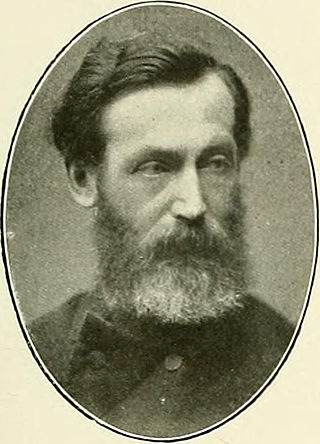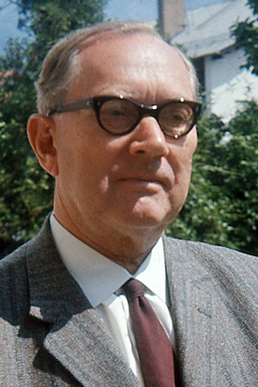Related Research Articles

Lichenology is the branch of mycology that studies the lichens, symbiotic organisms made up of an intimate symbiotic association of a microscopic alga with a filamentous fungus. Lichens are chiefly characterized by this symbiosis.
Charles Christian Plitt was a botanist and lichenologist. Species of lichens that have been named in Charles Plitt's honor are: Pyrenula plittii R.C.Harris, Xanthoparmelia plittii (Gyelnk) Hale, and Pertusaria plittiana Erichsen.

Irwin Murray Brodo is an emeritus scientist at the Canadian Museum of Nature, in Ottawa, Ontario, Canada. He is an authority on the identification and biology of lichens.

Ferdinand Christian Gustav Arnold was a German lichenologist and taxonomist born in Ansbach, Bavaria. Even as a high school student he showed an active interest in botany: "Ich und August Gattinger ... durchstreiften von November 1846 bis zum Spätherbst 1847, Pflanzen sammelnd, die Landschaft von München nach allen Richtungen.".
Chicita Frances Culberson was an American lichenologist.

The Acharius Medal is awarded by the International Association for Lichenology (IAL) for lifetime achievement in lichenology. The organization resolved at its 1990 meeting that it would simultaneously honor professional achievement and commemorate Erik Acharius by presenting a medal in his name.
Aino Marjatta Henssen, was a German lichenologist and systematist. Her father, Gottfried Henssen, was a folklorist and her mother was Finnish.
The International Association for Lichenology (IAL) is an organisation that encourages the understanding of lichens and lichenology, and promotes their study and conservation worldwide. It unites lichenologists across the globe, as well as national and regional organisations into one group. It is affiliated to the International Union of Biological Sciences (IUBS).
Syo Kurokawa was a renowned Japanese lichenologist and 1994 recipient of the Acharius Medal. He studied under Mason Hale and Yasuhiko Asahina.
Rolf Santesson (1916–2013) was a Swedish lichenologist and university lecturer. He was awarded the Acharius Medal in 1992 for his lifetime contributions to lichenology.
John Walter Thomson Jr. (1913–2009) was a Scottish-born American botanist and lichenologist, sometimes referred to as the "Dean of North American Lichens".
Thomas Hawkes Nash III is an American lichenologist. His research is about the biology and ecology of lichens, and the effects of air pollution on plants and lichens. He is known as an authority on the family Parmeliaceae. During his long career at the Arizona State University, he helped develop the lichen herbarium into a world-class collection with over 100,000 specimens representing more than 5000 species. In 2010, the year of his retirement, he was awarded the Acharius Medal for lifetime achievements in lichenology, and the following year had a Festschrift published in his honor.
John Alan (Jack) Elix emeritus professor in chemistry at the Australian National University, is an organic chemist who has contributed in many fields: lichenology, lichen chemotaxonomy, plant physiology and biodiversity and natural product chemistry. He has authored 2282 species names, and 67 genera in the field of mycology. Elix edited the exsiccata series Lichenes Australasici exsiccati.
Antonín (Toni) Vězda was a Czech lichenologist. After completing a university education that was postponed by World War II, Vězda taught botany at the Czech University of Life Sciences. In 1958, he was dismissed from his university position as a result of the restrictions placed on academic freedoms by the communist regime in power. He eventually was hired as a lichen researcher by the Czechoslovak Academy of Sciences, who allowed him to work from his apartment, which served also as an office and herbarium.
Leif Tibell is a Swedish lichenologist and Emeritus Professor at the University of Uppsala. He is known for his expertise on calicioid lichens. He was awarded the Acharius Medal in 2012 for lifetime achievements in lichenology.

Gunnar Bror Fritiof Degelius was a Swedish lichenologist. Between the publications of his first and final scientific papers, Degelius had a 70-year-long research career. While he was best known for his expertise on the lichen genus Collema, he also wrote important papers on lichen biology and ecology, floristic studies of the Nordic countries and various other areas around the world, and lichen succession. Degelius described 124 new taxa, and published about 130 scientific papers. In 1992 he was one of the first to be awarded the Acharius Medal for his lifetime contributions to lichenology. Fifteen species and three genera have been named in honour of Degelius.
Orvo Vitikainen is a Finnish lichenologist. He entered the University of Helsinki in 1961, from where he obtained a Candidate of Philosophy degree in 1966, and a Licentiate of Philosophy in 1971. He later earned a Ph.D. from this institution in 1994, under the supervision of Teuvo Ahti. Between the years 1961 and 1981 he was a junior curator of cryptogams at the University of Helsinki Botanical Garden, and then from 1983 to 2004 he was the head of the lichen herbarium. Here he managed the internationally valuable collections of the early lichenologists Erik Acharius and William Nylander. He has collected thousands of specimens for the herbarium from various locations in Finland, but also internationally, including Sweden, Norway, Denmark, Russian Karelia, Scotland, Austria, Italy, Hungary, Croatia, Montenegro, Tanzania, Kenya, British Columbia, and Brazil. In 1992–1994, he was a scientist of the Finnish Academy in the Ahti research group.

Jindřich Suza was a Czech professor of botany. He specialised in lichenology and phytogeography.
Hannes Hertel is a German lichenologist and taxonomist and was Director of the State Herbarium in Munich, Germany 1992–2004. His specialist areas are the fungi and lichens.

Robert Lücking is a German lichenologist, known for his extensive research on foliicolous lichens and his significant contributions to the taxonomy, ecology, and biodiversity of fungi and lichens. He earned his master's and PhD from the University of Ulm, focusing on foliicolous lichens. He has received numerous awards for his work, including the Mason E. Hale Award for his doctoral thesis, the Augustin Pyramus de Candolle prize for his monograph, and the Tuckerman Award twice for his publications in the scientific journal The Bryologist.
References
- ↑ Strain, Daniel (September 17, 2018). "Faculty in Focus: At 99, botanist's love of lichens still going strong". CU Boulder Today. University of Colorado Boulder.
- ↑ "Weber, William Alfred - biography". www.anbg.gov.au. Retrieved 2019-01-21.
- ↑ "Impressions of the Linnaeus Apostles' Achievements". IK Foundation. Retrieved January 19, 2015.
- ↑ Mary Jane Campbell, “Naturalist Weber Honored for Lifetime Achievement,” University of Colorado, October 30, 2014. Retrieved April 19, 2017.
- ↑ Monograph Series - Latin American Studies Center, Michigan State University. Latin American Studies Center, Michigan State University. 1977.
- ↑ "Lichenes exsiccati distributed by the University of Colorado Museum, William A. Weber, Curator: IndExs ExsiccataID=174322843". IndExs – Index of Exsiccatae. Botanische Staatssammlung München. Retrieved 23 September 2024.
- ↑ Tripp, Erin A.; Hogan, Timothy M. (October 2018). "William A. Weber Receives ABLS Lifetime Achievement Awards". Evansia. 35 (3): 106–109. doi:10.1639/0747-9859-35.3.106. ISSN 0747-9859. S2CID 189599622.
- ↑ "Obituary – William A Weber – Official Website" . Retrieved 31 March 2020.
- ↑ International Plant Names Index. W.A.Weber.
- ↑ "Acharius Medallists". International Association for Lichenology. Archived from the original on 24 June 2021. Retrieved 17 September 2019.
- ↑ "Acharius Award and ABLS Lifetime Achievement Awards". 14 November 2018. Retrieved 18 September 2019.
- ↑ Sérusiaux, E.; Goffinet, B.; Miadlikowska, J.; Vitikainen, O. (2009). "Taxonomy, phylogeny and biogeography of the lichen genus Peltigera in Papua New Guinea". Fungal Diversity. 38 (1): 185–224.